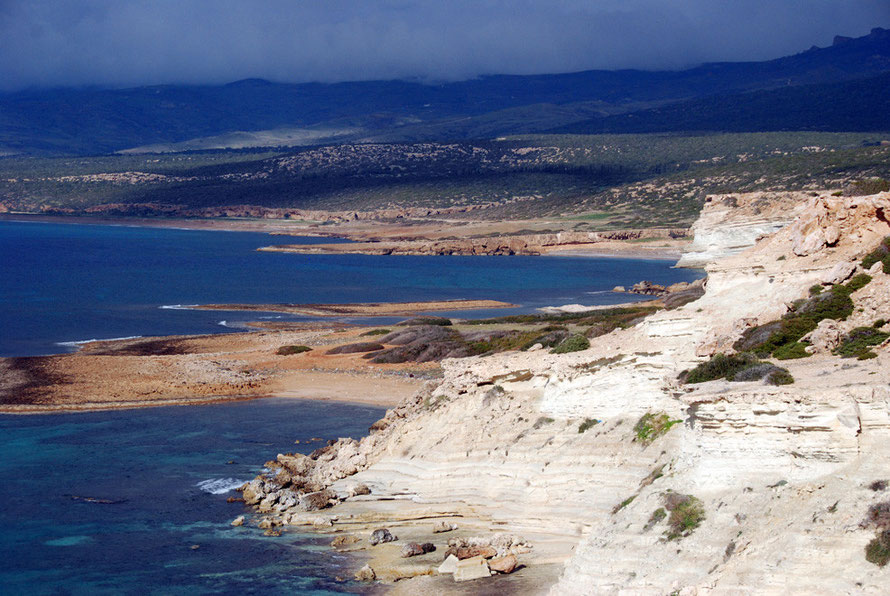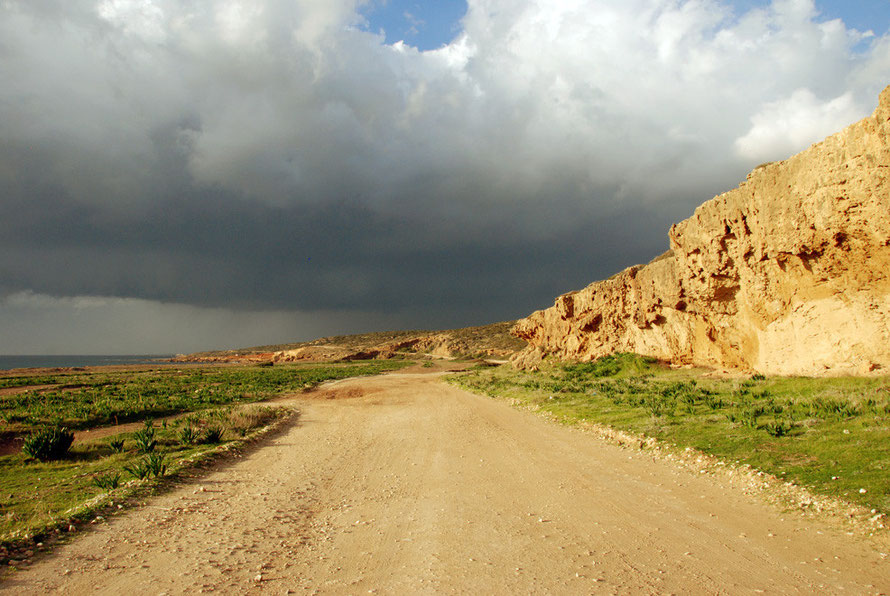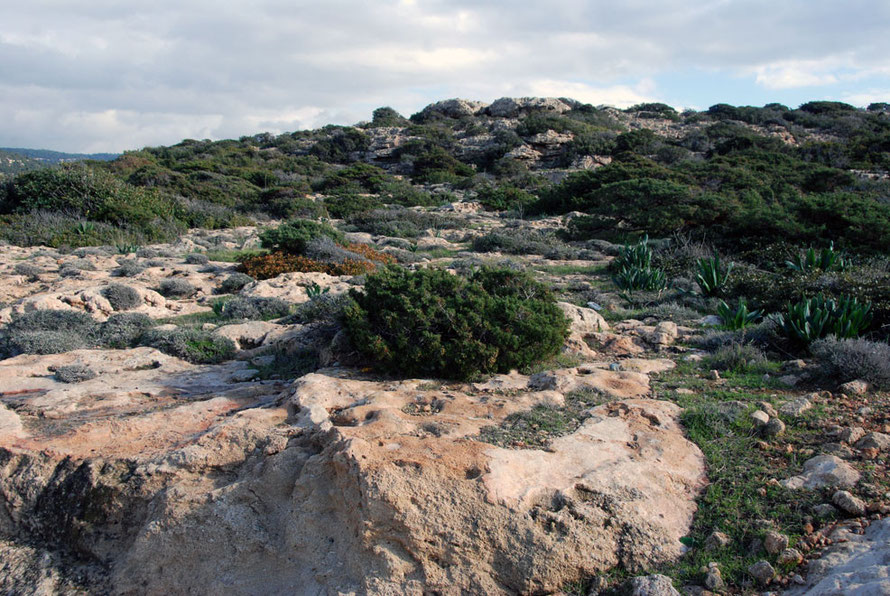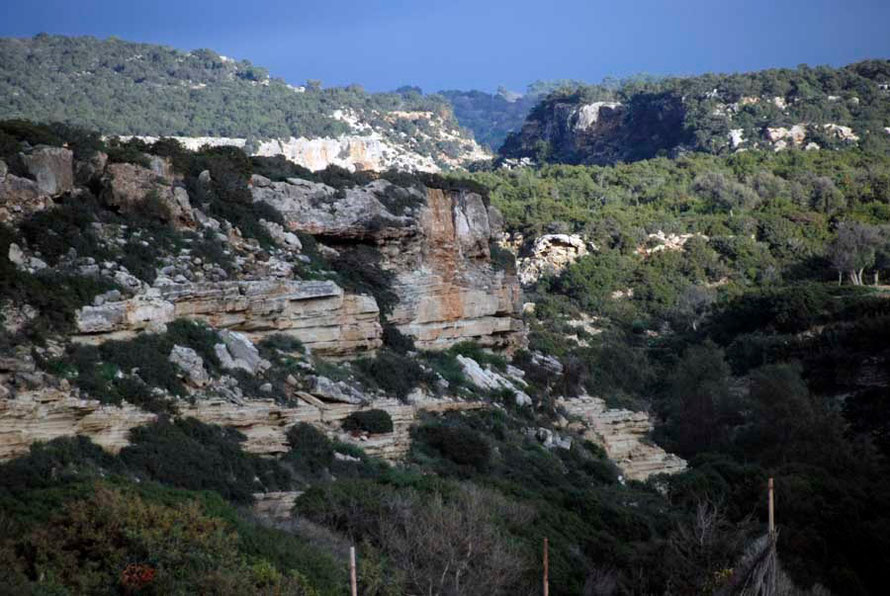Coast IV: Akamas in February

We turned off the Paphos road and climbed up over the shoulder of hills near Kathikas. Stopping to take photographs I stepped in the soaked marly soil. It was like porridge, sticking to my shoes for days. The stunted old vines weere balck against the light earth, waiting for the breath of spring to shock them back into life.
The hill down was spectacularly steep, and reminiscent of parts of the Apennines and the dry valleys of the Kumoan Hills in sub-Himalayan India. We passed a sign to Pegeia but were too eager to get to the turtle beaches of Cape Lara to make the three kilometre detour. When we got to the bottom of the hills we could see the villa sprawl running up from the once pristine Coral Bay to the top of the hills.

We followed little roads to another Agios Georgios. This took us to yet another fantastically located but closed fish restaurant with panoramic views over Cape Drepano and up the west side of the Akamas peninsula. The view was breathtaking: below us the light bounced off the bright crumbling and bedded marl cliff slopes. At the bottom of the cliff a short shelf collected boulders.
The calm sea lapped up against this, mottled turquoise and blending to darker blues. Behind the marl slopes the first Cape Lara beach pushed out into water, the sun dappled across the low sweep of maquis behind it. Further back the Akamas hills shouldered up into spectacularly dark cloud that we thought we had left behind in Polis.

I took three pictures of Agio Georgios harbour. The breakwater stretches out from the southern side and wraps around the harbour like a protecting arm. The water in the harbour was a brilliant light turquoise. A dozen boats floated serenely, now protected by the Akamas peninsula from the north easterlies. Behind the sea ran away to a crystal clear horizon that bent with the curvature of the earth.
We turned back to the car, the restaurant still firmly shut, the domed limestone block-built bread oven next to it alluring but cold.
Pressing on we came to a compact, squared-up modern church surrounded by a huge dusty car park. In front of the church was an old white Mazda van with a stall tied to it and a few battered tables but even this was closed. The church’s pristine stonework and clean lines sparkled in the sunlight. The orange tile roofed dome and bell towers glowed. Two aged tourists in white trainers were taking the sun on chairs to the right of the main door. I lowered the window and took a few photos, to their puzzlement. We then drove on, being careful not to rip the bottom out of the car exiting the car park.
Food was now far from our minds. The sun was shining and the Akamas beckoned. We drove back to the main road and followed a yellow sign for Akamas Point (18 km). The road was metalled and led us northwards along the coast through banana plantations. The banana trees were close-packed, 4 metres tall, some had toppled over and all had bright ultramarine heavy plastic bags over their fruiting arms. Goats and their kids grazed between the trees.
The small-scale plantation, like so much Cypriot agriculture, soon fell away and a broad vista of maquis opened up before us.
The land is a slightly inclined plain of weathered, grey and tawny and off-white knobbly, limestone that rises to higher points of more durable and exposed rock. Deeper, sharper oxide red holes punctuate the rock. And at times the smoothed surfaces show pools of rose pink colour.
Tucked into this skin of muscled limestone are stunted, ground hugging semi-arid plants. Green grey pillows of spiky Golden Drop (Onosma fruticosum) pistaccia lentiscus, rue, myrtle, tulips and juniper blasted by the coastal winds, stripped back to exquisite Zen garden skeletal traceries of bleached grey branches and twigs, the foliage burnt to watery a sienna.
A mosaic of bright rock and deep shadow, a tune of contrasting textures and forms, brought together in a harmony of sun bleached, washed out, subdued colours. A wind-sculpted hump of spiny lotus jujube-zizyphus lotus splendid in the sun. (For flora see).
We stopped in front of a sign telling us we were entering the Akamas nature reserve. Before it I bent down and picked a sprig of rue. Its pungent bitter-sweet smell was overpowering.
We got back in the car and drove down a steep concreted incline that took us below the bottom of the cliff line and past the last closed café on the road. We drove on across an unmetalled track, skirting the bigger potholes. At the next incline we left the car and continued on foot.
Below us was a meagre river bed running into the sea, a cliff wall of rock eaten away from the bottom up, a tumbledown troglodytic dwelling of piled stone built under the cliff with a ladder, gaping door, rusting galvanised fence and perimeter of thorn bushes. Beyond a flat tableland 2-3 metres above sea level, covered with tulip leaves, a yellow ochre stony track, another shelf of cliffs 10-20 metres high, honey combed, riddled, pockmarked, a rock face of ghastly moving faceless cowls, filled with dark shadow.
The pale ochre sandstone was worn to the thinness of fabric, curtains blowing immobile in the zephyrs of afternoon sea breeze. Dangerous to walk under the great rood screen of crumbling rock was seemingly held together by a suspension of gravity, in places worn to falling sand and an indecipherable relief script.

It was reminiscent of marble friezes where the original sculptural intent has been worn back to a different more elemental and enigmatic language of unknown signs and glyphs.
Great crusty outliers and boulders of the diseased rock lay on top and at the base of the cliffs. The sun lit phantasmagoric shapes against the bruised mass of dark cloud beyond. And above these sandstone cliffs the maquis receded and rose to the next layer of harder limestone.
This is the arid land of the endemic Cyprus lizard (lacerta leavis troodii), the Spiny-footed Lizard (acanthodactylus schreiberi), the Cyprus White-toothed Shrew (crocidura cypria), and hedgehogs, hares, foxes, vultures, gier falcons, partridge, snakes and the Green Toad (bufo viridis).

We walked along the flat tableland above the beach, playful waves catching and dazzling in the sunlight. Every now and then a 4x4 would pass but otherwise is was blissfully quiet but for the occasional stonechat and passing flocks of excited goldfinches.
We walked along the beach where the rare and endangered green turtle (chelonia mydas) and the common turtle (caretta caretta) turtles still come to lay their eggs.

‘The Green Turtle, is the rarer in the Mediterranean and, with a population of probably less than 1000 nesting adults, is now in imminent danger of extinction in this sea. In the Mediterranean it now breeds mainly in Cyprus and in some beaches in Turkey. The sea turtles arrive here from various parts of the Mediterranean to lay their eggs. They nest in summer, from the beginning of June to the end of August. They nest every 14 days, laying 3-5 clutches of eggs in the season. Each time they lay about 100 eggs. They hatch some seven weeks later.
In the past Green turtles used to breed on other beaches in Cyprus also, on beaches such as those of Ayia Napa, Protaras and Potima. Some are now well-known tourist beaches, others have been ruined by sand extraction. Loggerhead turtles also nest in the Polis beaches and, in small numbers, on most other beaches which provide some privacy at night.

We took off our coats and sat and ate olives and drank water by the sea’s crescent edge as the small waves splashed in, brilliant translucent emerald green and blue, the foam staggering in its whiteness and brilliance, all the while the great dark sky to the north brooding and bruising the Akamas hills.
It was one of those places that invokes a panic of photography. I had a desperate desire to capture the scene, the feel, the smell, the sound, the possibility, the potential, the seasons to come, the moonlit nights of turtles huffing and puffing to make hollows in the sand for their eggs. Our presence was so transient, our visit so brief, the winter day running its course, our stay on the island almost over.

The Department of Fisheries started a programme in 1976 aiming at the conservation of the turtles that breed in Cyprus. In addition to other measures, a station-hatchery was set up at Lara in
1978. The project aims among other things at increasing recruitment of young turtles into the population. This is achieved through the protection of the turtle nests from various dangers such as
predation by foxes and inundation by the sea. About 80% of the eggs laid on the beaches of Cyprus are either eaten by foxes (as eggs or hatchlings) or perish by getting covered by the sea. Each
year some 6,000-7,000 young turtles are hatched either in hatchery or under protection in situ, and then set free. The Lara - Toxeftra area has, since 1989, the status of a protected area under
the Fisheries Legislation, with management regulations in place during the nesting and hatching season.’ Source:Andreas Demetropoulos
The beach was a mix of pinky yellow sand, shingle, pebbles and boulders of immaculate white limestone, harder grey and reddish rocks, even some rafts of concrete, a few flat blades of the sea grass.

We walked back beneath the crumbling cliffs, the sun strong but already sinking. We crossed the brook that runs out of the Avakas Gorges to the east and heard once more the strident call of that invisible bird concealed in the lotus bushes or amongst the reed bed.
A track led up toward the gorge entrance and we were tempted to take it but time pressed. Above the track was the flat, reed-roofed shape of a medieval fort with two palm trees standing sentinel over it. At the top of the rise by the car we took our last pictures, Cape Lara still splendid in its muted maquis, its gash of bright oxide red, its dazzling cliffs and boulders, the sea at its feet and the sky towering above, darker now and closing in.
The future of the Akamas is troubled. The Rough Guide notes despite the designation of the Akamas coast as a ‘specially protected area it did not stop 25 lorry loads of sand being illegally carted away from Toxeftra Beach by minions of Bishop of Pafos for use on a golf course. Apparently ‘sand-filching’ has stopped although we saw deep caterpillar tracks on the beach where someone had been shifting sand. The archdiocese of Pathos apparently still wants to put up a luxury resort within sight of Lara despited being offered generous compensation from the World Bank in exchange for dropping opposition to the establishment of a national park here, which would incorporate some of its property. p.175 The Rough Guide to Cyprus 6th Ed 2009.
We drove back to Pafos through the banana grove and then the endless suburbs of villas and the interminable strip of pubs and eating places and shops and car hire outlets. Once on the motorway fuelled up and sustained by chocolate and sweets we sped along in the dying light. It was a long drive back to Nicosia and true night had fallen by the time we reached Limassol. Fortunately there was no rain and the windscreen wipers were not needed. Two hours later we arrived back exhausted and exhilarated. Wine, a mixed grill, a Village Salad and a catch-up on the news coming in from Egypt and we went to bed.








